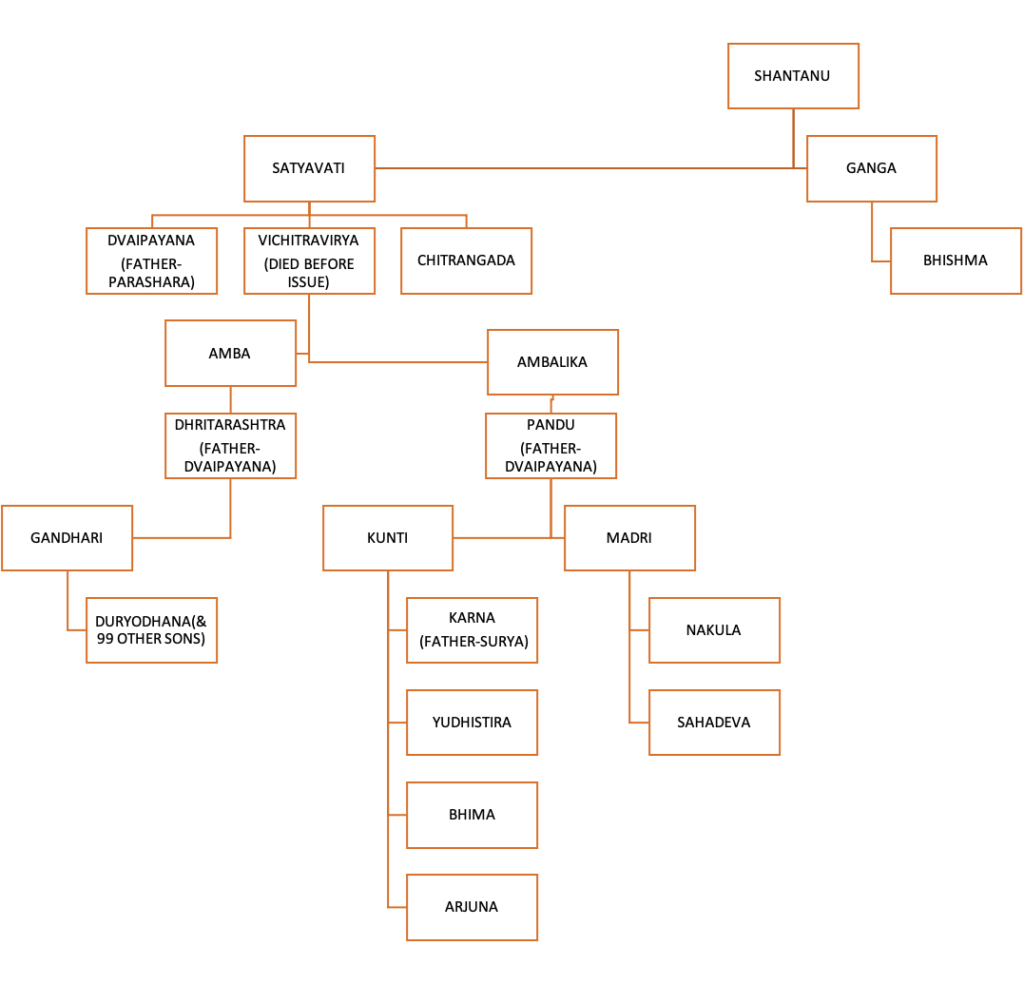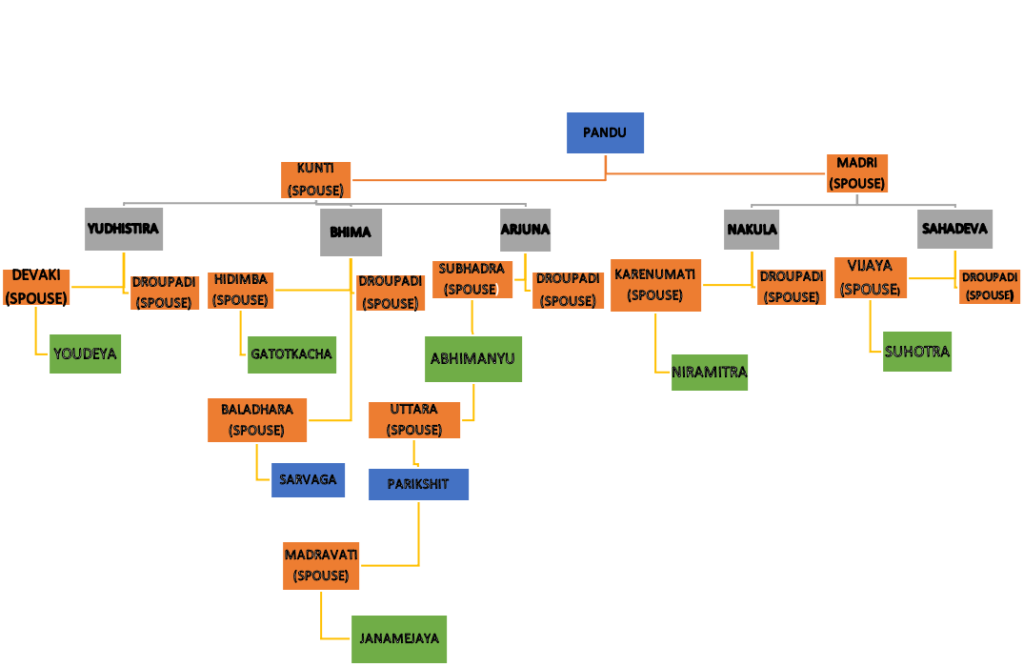About Mahabharata

“Whatever is found here on dharma, artha, kama and moksha, may be found elsewhere. But whatever is not in it, cannot be found anywhere else.”
-The Mahabharata 1. Translated by, Bibek Debroy.
Often called the greatest story ever told, the Mahabharata is also known as the longest epic poem ever written. The epic consists of over 98 (or 18, depending on the classification) parvas or episodes; with 2113 adhyayasor chapters; approximately 2 million words; and 90,000 shlokas or couplets. It was originally composed by Krishna Dvaipayana Vedavyasa in around 8th-9th century BCE; however, multiple authors worked on it for over a period of thousand years and the story we know and love today was completed in 4th century AD. It is also referred to as the fifth Veda.
The core story of the epic is based on the dynastic power struggle between the Kouravas and Pandavas, who were the children of two brothers belonging to the Kuru dyanasty—King Dhritarashtra and King Pandu. The epic is written in a story within a story format and there are multiple plots and sub-plots in the build-up to, and after, the Kurukshetra war fought between the cousins.
The main theme of the epic revolves around the importance of upholding Dharma, or sacred duty, above all else. The Pandava brothers, especially Arjuna and Yudhistira, didn’t necessarily want to fight a war against their own kin. Famously, in the Bhagavad Gita part of the Mahabharata, a distressed Arjuna is overcome with doubts about the morality of violence and killing whilst he is in the middle of the battlefield. He expresses his reservations about fighting against his own kind to Lord Krishna, who is his counsel and charioteer at the time. Lord Krishna urges him to think about his dharma; he explains to Arjuna that as a Kshatriya it is his duty to fight and that he must uphold it.
The story of Mahabharata was mainly told in the oral storytelling tradition (unlike the precise retelling of the Vedas) by charioteer bards who were called Sautis. The first chapter of Mahabharata also begins with a retelling of the story of Mahabharata by Sauti to the sages gathered for a snake sacrifice organized by King Janamejaya (Arjuna’s grandson). The epic starts with history and genealogy of the princes of the Kuru dynasty. Successive chapters tell the story of the Kauravas and Pandavas; their life and relationships; dynastic politics; the Kurukshetra war and the aftermath; and ends with the death of the Pandavas and their entry into the spiritual world.

More about the Kurus, Kauravas and Pandavas:
The sons of Dhritarashtra are called Kauravas; and the sons of Pandu are called Pandavas. They belong to the Kuru branch of the legendary Chandra Vamsha or Lunar dynasty (in contrast, Ramayana is the story about the Soorya Vamsha or Solar dynasty). Some of the more notable rulers belonging to the Chandra Vamsha include: The great Emperor Bharata; his father, Dushyantha (who married Shakunthala); Krishna belongs to the Yaduvansh branch of Chandra Vamsha.
Several semi-nomadic tribes united after the Battle of the Ten Kings to form the Kuru clan. Their rule lasted from the middle Vedic period to late Vedic period; i.e., about 1200 BCE to 500 BCE. The Kingdom of Kuru included modern-day states of Haryana, Delhi, Punjab and parts of western Uttar Pradesh. The tribes practiced semi-nomadic pastoralism, agriculture and trade. The Kuru kings supplemented their income by raiding their neighbors, and demanding bali (tribute).
The Vedas, which were both composed and transmitted orally with precision in the early Vedic period, were arranged into texts under the Kuru rule. A culture of caste system and Srauta rituals (rituals based on the Vedas; e.g., Homas) also emerged under their rule; particularly under the rule of Parikshit and Janamejaya. The new social order was used to further cement their power.

Thoughts:
- The Mahabharata is a Sanskrit text. Unfortunately, my knowledge of the language is limited to a few words at best.
- Many versions of the Mahabharata are available; but very few complete and unabridged versions in English exist. I am reading The Mahabharata (complete and unabridged), translated by author, Bibek Debroy. I also like, The illustrated Mahabharata by the same author.
- Mahabharata is described as Itihaasa—a traditional retelling of past events. Essentially, The Mahabharata gives us a glimpse at the life of the people in the Kshatriya varna (Warrior class) belonging to the Lunar dynasty; we learn about important events, places and people of the time; also, the traditions, myth and legends that existed in that period.
- While the Mahabharata is based on real events, and the existence of some of the Kings and events in the story has been proven beyond doubt, I think it is important to remember that it is a story. As to what are historical facts and which parts are fiction, I personally feel that it is best left to scholars and researchers to discuss.
- The rise of Vedic tradition during the Kuru rule saw a strengthening of a mutually beneficial Brahmana-Kshathriya relationship during this period. This resulted in an increased power for the two groups both socially and politically. Stories in Mahabharata promote these Kshatriya and Brahmana heroes from the Vedic culture.
- The way the epic is formatted is a little bit chaotic, to be honest. At times it is difficult to keep track of some of the details of the stories; it goes into tangents or completely digresses. (Probably a result of having multiple authors over a long period of time? Too many cooks…?) Still, I find it a fascinating read.
The End.
Source:
The Mahabharata 1: Complete and Unabridged; translated by Bibek Debroy. (2015). Penguin Random House India. (Original work published 2010)
The Illustrated Mahabharata: The Definitive Guide to India’s Greatest Epic. (2017). Dorling Kindersley India.
Witzel, Michael (1995). “Early Sanskritization. Origins and Development of the Kuru State”. Electronic Journal of Vedic Studies. 1-4: 1-26
Image: https://free-images.com
Podcast music: StockMusic. (2018). Drum Jam[Recorded by Bobby Cole]. On World Rhythms and Moods SM066.(Year recorded 2018)
- What Drona & Arjuna’s Story Teaches Us About Success, Destiny
- See Why Shakuntala Says A Wife Must be Cherished
- Samudra Manthana:Story of the Quest for Immortality
- Ekalavya’s Tragic Sacrifice: Why The Archer Sliced His Thumb
- Dhritarastra, Pandu, Vidura: Birth; the struggle to revive a dying lineage.
- ©storiesofindiaretold copyright 2022 all rights reserved
